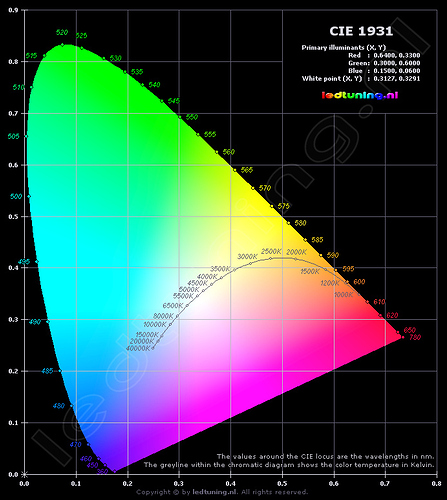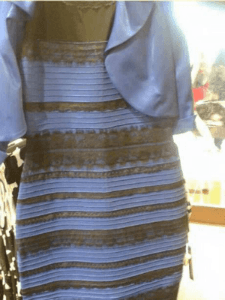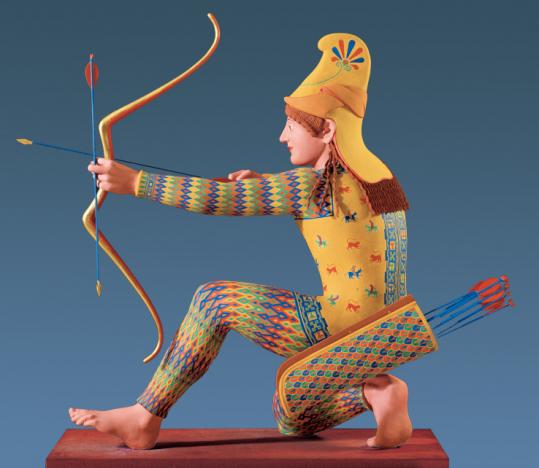Reading this article a couple of days ago. Imagine how it would translate to sound similar experimentation, I’d imagine that there would be even differences in how men and women perceive sounds. Or population living in extreme altitudes hearing differently than those living near sea level.
I know that this is true to some extent to sound perception. I remember having a conversation with Mr. Rok from Ollo Audio, and he said his team found out about studies that proved that people that live in villages hear differently than those in cities (or somewhere else).
Sound perception is a truly fascinating and complex topic. I think that there are many factors that can change the way we perceive sound.
We talked about this in lighting class at uni. Green and red are very visible, blue, not so much. So if you need to make text visible, yellow background, blue text.
The curve in the following chart is “color temperature” (= temperature of a tungsten element to get that color)
Edit: replaced with proper CIE1931 chart
Did they tell you why green and red are the most visible? Picking ripe fruit.
Going by color codes, it is blue-ish white and medium brown.
Maybe it’s just all the RGB LEDs in everyone’s keyboards, mice, cases,
fans, GPUs, AIOs, RAM, SSDs, monitors and microphones throwing people off.
“I thought the dress was blue and gold, but then it kept cycling rainbow colours.”
The different sensitivities to colors even holds true for point sources. There’s a well known double star system in Cygnus in which one member is orange-ish and the other blue-ish when you look at it through a telescope. You can look at another double star with essentially the same measured brightness differences between the two members and the apparent difference to your eye will be much less if the colors of the two stars are similar to each other.
I always knew the sky was red. Didn’t let “the man” gaslight me into thinking it’s blue 
Yellow and blue make green.
Okay I need to point out that when Blue was a common pigment in mesopotamia and ancient egypt, china and India. As well as spectrographic analysis of greek and roman statues (which were painted, not white) have samples of blue pigment on them.
The whole thesis comes from some british dingbat in the 1800s based on the odyssey, conveniently forgetting that Homer was
A) BLIND, possibly from birth
B) A POET
Roman Statues, showing clear differentiation between blue and green as pigments in color choices
Greek
A lot of the reason you dont see blue that often in ancient art as well as violet/purple was the relative expense in acquiring and refining them. So they eventually just became associated with religious and royalty. Hence terms like royal blue and why violet is connected with the british royal family
There is a difference between evolution time scale (hundred thousands of years) and cultural time scale (hundreds of years).
That article has nothing to do with evolution, though. At all. It’s entirely rooted in the Homeric theory put forward by William Gladstone and the “language defines cognition” theory and none of its references go farther back than the greek period
AFAIK mammals developed receptors for blue 30 million years ago.
The “no word for blue”-thing is meh. I am no expert, but I would strongly argue for a “lost in translation”-mistake.
Edit: It should be noted that the cave paintings found around the world lack blue colors. That is neither here nor there since there are not many blue things in nature.
What language tends to do is make people… more aware of variances they already implicitly know by sense, simply by the nature of having definitions for it. Our ability to describe sound very clearly when it comes to audiophilia makes it sound like we hear more but really what we have is language to better communicate it.
Kind of like people who do a lot of woodworking have different words for grain, texture hardness and quality of wood that we can all feel and implicitly understand but since we dont know the sublingo enough we really cant get more than Hard, soft, rough smooth without becoming unweildingly verbose in our attempt to define something we lack the language to parse quickly
(also the greeks had several words for blue, differentiating sky, sea, day and night)
(I lent my mom my focal stellias and she heard what made them special to me, but since she lacked the vocab, she could only describe it as more detailed)
To further a couple of PABastien’s points:
Blue and green are used appropriately in Roman tile mosaics with the sky consistently blue and foliage consistently green.
Homeric poetry like nearly all poetry in pre-literate western societies was built using stock phrases for ease of memorization. Essentially, the story teller used a store house of stock phrases plus a meter scheme then gave recitations partly from memory and partly by combining the two into an almost rap-like improvisation based on the well-known story line. Wine-dark is one of those phrases and may well have preceded Homer.
Further, today we immediately think of wine as either some shade of red or pale yellow. But concord grapes are blue-black. Not sure it’s been established what colours ancient wines came in, but for all I know it may well have been a nearly black purple or indigo.
The talk about the first pigments of blue being used by Egyptians, so before the Romans & Mesopotamians, they also talk about African tribes in in Ethiopia… read further, it’s an interesting article.
The idea of the article isn’t about Homer’s description, it’s about the lack of a word for blue. Be honest, who go to the end of the read before commenting? 
In any case, there is evidence that we see colors differently, or certainly have higher or lower sensitivity to colors based on geographic divergence, epigenetics, whatever the reason, but they clearly exist.
Yes, but it’s still fun to poke holes in the Gladstone meme. Doubt if he minds. I first encountered it as supposedly revelatory information coming from psychic Edgar Cayce recorded in a book of him speaking in a spirit possessed trance decades ago, lol.
But they did have words for blue…
“In any case, there is evidence that we see colors differently, or certainly have higher or lower sensitivity to colors based on geographic divergence, epigenetics, whatever the reason, but they clearly exist.”
100 percent agree with this and I feel these biological differences are the root cause more than anything and is simply being associated with language rather than a simple statistical conflation.






